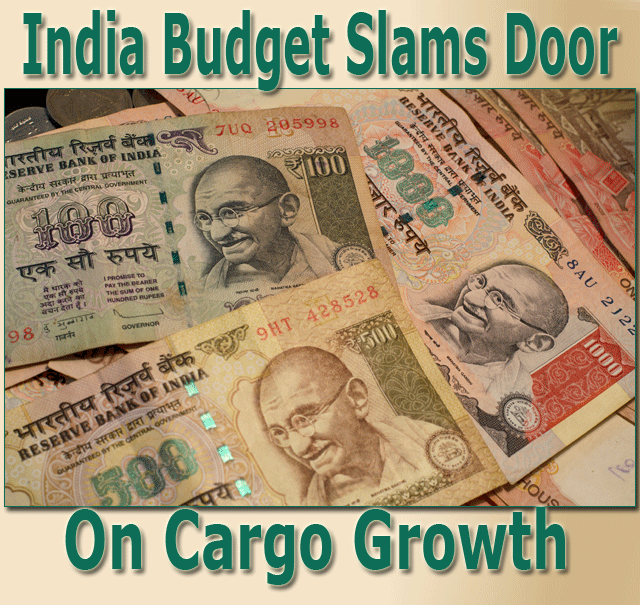 |
Ahead of next week’s Air Cargo India
trade show event scheduled for Tuesday, February 25-Thursday, February
27 at Grand Hyatt Mumbai Hotel & Residences, comes
word of impact felt as the China Covid-19 news worsens. Add to that the
recently released Government of India Annual Budget, squashing hopes for
anticipated cargo infrastructure improvements at India’s largest
gateways.
Hyped as the ‘make or break’ the
widely reported Indian Budget, announced on January 30, might have delivered
hope to the aviation community and air cargo stakeholders.
Last year, the 2019 Budget had raised expectations
about momentum that seemed to indicate that India would enter the aircraft
financing and leasing market, as policy to increase foreign direct investment
into Indian airlines.
But all of that went by the boards for 2020
as in the 2020 Budget, aviation received a cursory mention.
Of course, there was the announcement that
100 more airports would be built by 2024 to support the Prime Minister’s
ambitious last mile connectivity scheme that would allow the common Indian
to fly.
These moves, however, would direct attention
to smaller regional airports that do not impact, the continued major gateway
airport capacity challenge.
CRISIL Clear
 Last week quoting a study by CRISIL, Fortune
India reported: Last week quoting a study by CRISIL, Fortune
India reported:
“Congestion at India’s four
major airports—New Delhi, Mumbai, Bengaluru, and Hyderabad, which
together handle over half the country’s air passenger traffic—would
continue over the medium term. Currently, these airports on an aggregate
operate at over 130% of their capacity. With healthy passenger traffic
growth projected, this rate is expected to rise further in the next 12
months.
“Capacity at these four airports will
increase a cumulative 65% to 228 million annually (from 138 million now)
by fiscal 2023. However, traffic is expected to grow strong, at up to
10% per annum over the same period,” says Manish Gupta, senior director,
CRISIL Ratings. “Because the additional capacities will become operational
in phases only around fiscal 2023, high passenger growth will add to congestion
till then.”
 National
Logistics Policy National
Logistics Policy
For air cargo, India’s Finance Minister
Nirmala Sitharaman promised funding for the much-awaited National Logistics
Policy to develop a single window e-logistics market in the country for
faster movement of goods.
“The policy will clarify the roles
of the Union Government, State Governments and key regulators and create
a single-window e-logistics market and focus on generation of employment,
skills and making MSMEs competitive,” Minister Sitharaman declared.
Down On The Ground
The situation on the ground, the big picture
of the State of India itself, unfortunately is anything but promising.
With global geopolitical hurdles, increasingly impacted by coronavirus,
the Indian economy has entered a slowdown mode with declining consumer
demand and reduced private sector investment.
Add to that the general unrest in the country
with the passing of the Citizenship (Amendment) Act, 2019 that has seen
women and youth in large numbers demonstrating in the streets of Mumbai
and elsewhere.
 Budget
Pushback Budget
Pushback
Former Secretary-General of the Federation
of Indian Chambers of Commerce and Industry (FICCI) and now Finance Minister
of the state of West Bengal Amit Mitra was scathing in his criticism of
the 2020 Budget.
He said, "Before the budget, the Indian
economy was in the ICU. “But after the budget, it will go straight
to the ventilator.
“This is an anti-people and thoughtless
budget that leaves people at the bottom of the pyramid in every way.”
Air Cargo Decline in 2019
In 2019, the economic slowdown impacted
Indian air cargo resulting in a 5.3 percent decline in freight traffic.
Result: Order cancellations and deep discounts
in freight rates. Add to that there were no new buyers.
According to studies, cargo companies had
scaled down their growth projections for the full financial year.
The numbers have been borne out by reports
from the Ministry of Civil Aviation, which said that aircraft movements
and freight traffic had decreased by 1.2 percent and 4.7 percent, respectively.
Those figures, incidentally, were from August 2019. At that time, carriers
like IndiGo and SpiceJet, transporting goods in aircraft bellies, were
keen to increase their share.
IndiGo’s CEO was quoted saying: “We
are now focusing on inbound cargo business from Southeast Asia and Middle
East and I am very pleased with the response we are getting on these sectors.”
Those last figures from the Airports Authority
of India (AAI) only underscore the trend.
Domestic air cargo, for instance, in April-October
2019-2020 was 8,05,488 tons while in the same period in 2018-19 was 8,03,554
tons, a change of 0.2 percent.
International cargo followed the same route:
in April-October 2019-2020 was 12,05,123 tons while in the same period
in 2018-19 was 13,13,312 tons, a -8.2 percent change.
India Airports & ICEGATE
A look at the major international airports
once again brings front and center the appalling need for the infrastructure
improvement long overdue.
There are long lines of trucks waiting and
the Customs ICEGATE (the Indian Customs and Central Excise Electronic
Commerce/Electronic Data interchange (EC/EDI) Gateway, a portal that is
supposed to provide e-filing services to the trade and cargo carriers
and other clients of Customs & Central Excise Department) is often
off line and not working.
Nostradamus Could Not Have Predicted
As a veteran freight forwarder put it, “We
are happy that the government took the initiative to launch ICEGATE and
usher in steps to ease business processes through a single window system.
“Government has allowed us to set
up Air Freight Stations.
“These initiatives,” he said,
“have borne fruit. 75 percent of air cargo gets cleared in less
than 48 hours with Delhi being the fastest among metros, according to
the time-tracking color dashboard recently launched by the Central Board
of Indirect Taxes & Customs (CBIC).
“But, even Nostradamus could not have
predicted what we are going through.
“Economy is down and now with Coronavirus,
the situation has gone from bad to worse.”
The veteran freight forwarder who asked
that his name be withheld, makes the point.
Coronavirus Pandemic Impact
“Coronavirus has already started impacting
electronic products like mobile displays, open cell TV panels, printed
circuit boards, capacitors, etc. accounts.
“Such products are essential for TVs
and smartphones.
“Already, Chinese suppliers have hiked
prices making phones from Xiaomi, Vivo, Oppo, OnePlus, etc. costlier.”
Other than electronics, the auto industry—already
depressed for quite a few months now—is also expected to be affected.
Electric vehicle manufacturers will also
find the going tough, with parts supplies dwindling.
Nitinraj
|




